Just published last month, the latest version of TC 3-21.76, Ranger Handbook, supersedes the previous version of 26 April, 2017.
Download you copy here.
Just published last month, the latest version of TC 3-21.76, Ranger Handbook, supersedes the previous version of 26 April, 2017.
Download you copy here.
(McLean, VA — October 1, 2025) FN America, LLC is pleased to announce that it has been awarded a Prototype Project Opportunity Notice (PPON) contract valued at $2 million, by the U.S. Army to further develop its submission for the Precision Grenadier System, a next-generation primary soldier weapon system and family of ammunition that enables precision engagements to destroy targets with increased lethality and precision compared to legacy grenade launchers.

The FN Multi-purpose Tactical Launcher 30mm (MTL-30™) that was designed in the U.S. and will be manufactured by FN America at its plant in South Carolina is a soldier-portable, semi-automatic, medium-velocity, flat trajectory grenade launcher that enables warfighters to engage targets at extended ranges with more effective payloads over existing technologies. After extensive testing, FN’s solution has successfully met the DoD’s key performance criteria while also delivering desired characteristics. In addition, the FN solution is easily manufacturable and logistically supportable due to state-of-the-art manufacturing techniques, ensuring the program will be cost-effective.
“This program is a U.S. Government priority with the shift in modern warfare and engagements, and FN is honored to be selected to develop this new, innovative solution,” said Mark Cherpes, President and CEO for FN America, LLC. “Once developed and implemented, this weapon system could radically change future battlefield strategies. It will offer new capabilities at the squad level and upgraded tactical options, giving the warfighter a more effective system.”
FN’s solution, the FN MTL-30, is the first in this family of launchers and ammunition, as FN works with the Department of Defense (DoD) to help solve one of the world’s most pressing battlefield needs.
“The FN MTL-30 shoulder-fired launcher can engage in close-quarter warfare, defeat targets in defilade, and engage unmanned aerial systems (UAS). It could also be networked with FN remote weapon stations to create a multi-layered defense against UAS,” said John Bungard, Sr. Director, Military Development Programs for FN America, LLC. “Providing solutions that can counter multiple threats is critical for future battlefield engagements. We are excited that the Army is interested in maturing our PGS solution. We are fully committed to this system and its development.”

The FN MTL-30 is chambered for 30mm medium-velocity grenades and features a detachable box magazine with 3- or 5-round capacity. At just 35 inches in length and 8.5 inches tall, the weapon weighs just over 10 lb. The bolt catch, magazine release and safety selector are all ambidextrous, plus there is an M4-style telescoping buttstock with a modular cheek riser. The modular rail system has a contiguous top rail for mounting of visual augmentation systems (VAS) and other devices, plus side M-LOK® slots with a MIL-STD Picatinny rail.
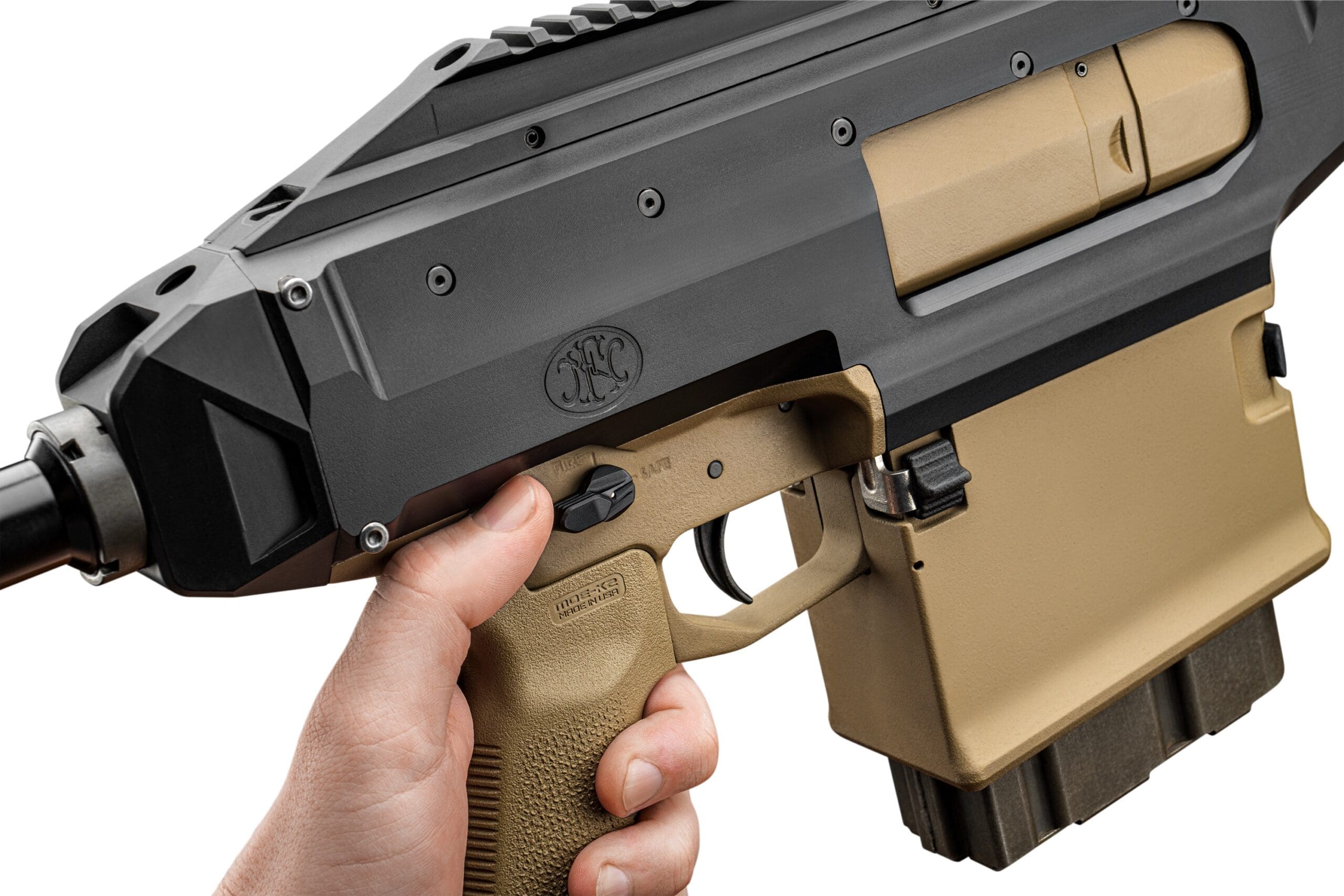
For the soldier, the FN MTL-30 is lighter and more streamlined than previous options. Real time soldier feedback has led to a prototype that is far more user-friendly, incorporating a footprint users will be familiar with due to the M4-style controls, grip and buttstock. The system features a soft shooting launcher with low-felt recoil, enabling rapid target engagement with effective payloads from an extremely controllable system. In addition, FN’s modular system is fully serviceable at the user level and has high parts commonality with existing components.
“The technologies we have incorporated have allowed FN to create a system that is much lighter, more compact and more maneuverable than previous soldier-operated grenade launchers,” said Jim Williams, Vice President, Military Programs for FN America, LLC. “This will improve soldier capabilities on the battlefield, offering a robust solution for close combat, engaging targets beyond 500m or to potentially combat other threats such as unmanned aerial systems.”
Throughout its history, FN has been one of the largest suppliers of small arms to the U.S. military and continues to develop innovative, future technology. In addition to this opportunity, the company currently holds contracts for the FN® M240 and its variants, the FN® M249 lightweight machine gun; the FN® MK 46, MK 48, MK 17 and MK 20 SSR for USSOCOM and various other contracts. FN has decades of experience designing and supplying various grenade launching systems. The company produced the MK 19 fully automatic 40mm launcher, the MK 13 EGLMthat was a part of the SCAR program and currently sells the FN 40GL® standalone launcher internationally.
For more information about FN’s military product line or current U.S. military contracts, please visit www.FNAmerica.com.
As part of Pegasus Charge, 1st Cavalry Division’s effort in support of the Army’s “Transforming in Contact” initiative to modernize armored formations, soldiers assigned to the 2nd Armored Brigade Combat Team, 1st Cavalry Division, conducted Fort Hood’s first live-fire exercise of the Switchblade 600 Loitering Munition System, Sept. 15.
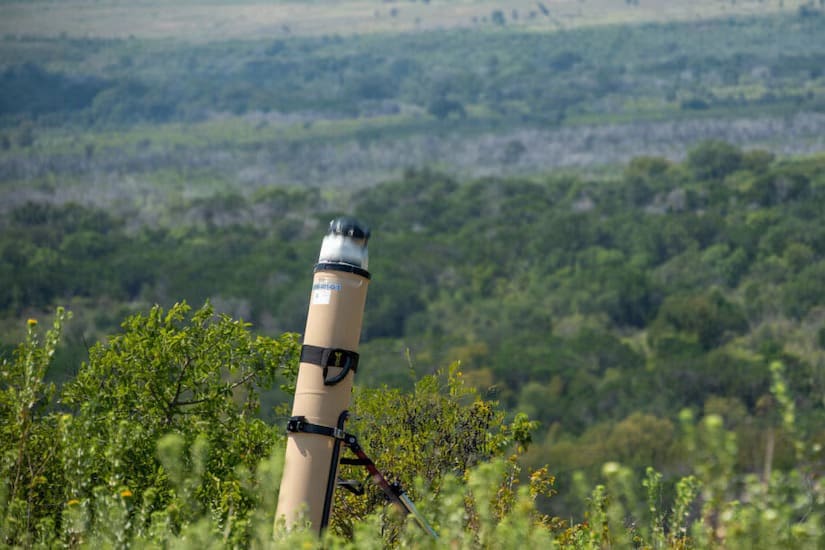
The Switchblade 600 — a tube-launched, unmanned aircraft system — has already seen extensive use by Special Operations Forces, light infantry units and foreign partners. The 1st Cavalry Division is among the first armored units to field the system.
“This is the first time for all of our soldiers to see these munitions fired, and you can feel the excitement in the air,” said Army Capt. Jeffrey Weller, Multifunctional Reconnaissance Troop commander, 2nd Armored Brigade Combat Team, 1st Cavalry Division. “The Switchblade enables the brigade to engage targets with precision between 5 and 15 kilometers in front of our forward line of troops, extending our reach and lethality.”
Modernizing the Fight
The Army’s broader Transforming in Contact initiative aims to overhaul how armored formations fight by integrating new technologies, particularly drones and advanced communications.
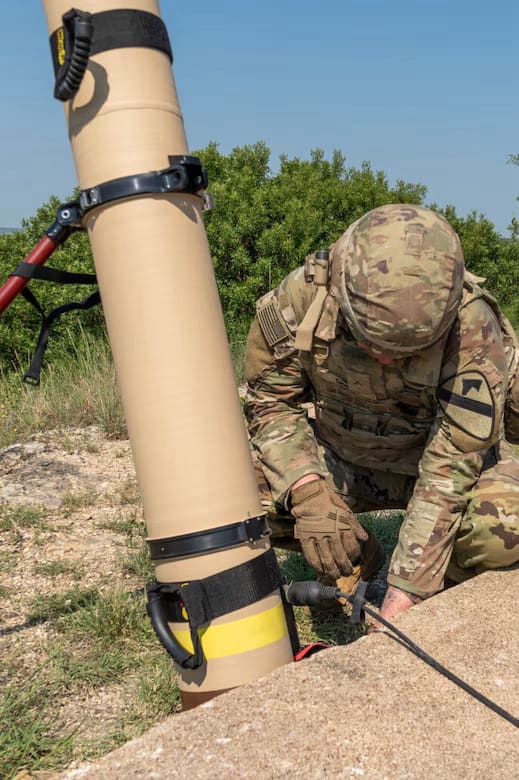
“A huge thing the Army has seen across multiple battlefields, whether in Ukraine or elsewhere, is the rapid modernization and high usage of drones,” Weller said. “We’re taking those lessons learned and revamping our [unmanned aircraft] systems to stay ahead of adversaries.”
Roughly 5 feet long and weighing 75 pounds, the battery-powered Switchblade 600 resembles a drone, but carries a Javelin multipurpose warhead. It has a flight time of 40 to 45 minutes, a range of up to 27 miles and delivers a 5-pound explosive payload.
“It’s a remote-controlled missile that flies like a drone until it gets to the target,” explained a flight operations supervisor with the system’s manufacturer. “The operator uses onboard cameras to identify, select and engage the target.”
Once launched from its tube, the Switchblade can navigate through waypoints, loiter over the target area and strike with precision. Operators also retain the ability to wave off a strike mid-flight if conditions change.
“The Switchblade allows us to target vehicles or small groups of personnel from much farther away than before,” Weller said. “It increases our lethality, minimizes collateral damage and helps protect soldiers on the front lines.”
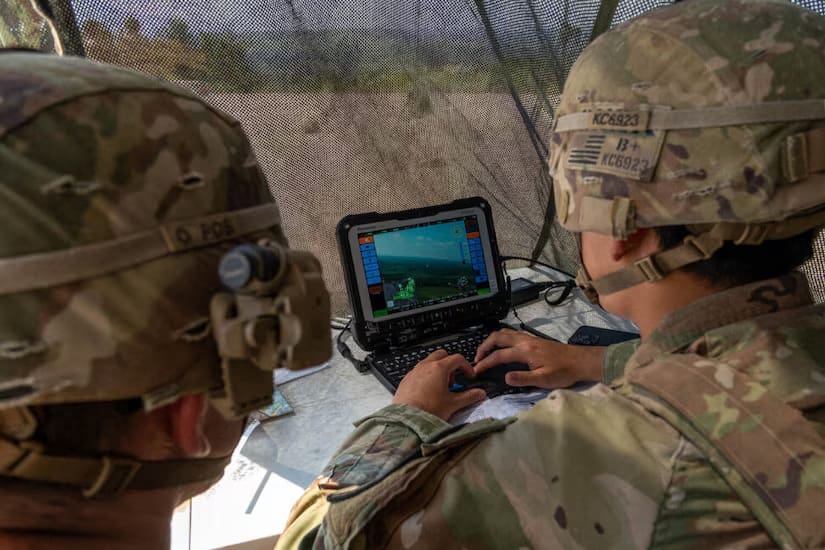
Before the live-fire exercise, soldiers completed a five-day training course with the manufacturer, during which they learned to set up, arm and program the drones for flight and strike missions.
Army Spc. Drake Cross, a Switchblade operator who has flown RQ-7 Shadow and RQ-28 Quadcopter drones for the division, said this was his first experience with a munition-carrying UAS.
“Everything else I’ve flown has been for surveillance and target acquisition,” Cross said. “This is the first one where I can actually deliver a round. It’s exciting because it saves soldiers’ lives by hitting targets without putting us in danger.”
Cross said the system was user-friendly and similar to other UAS platforms, adding, “There’s not much of a learning curve. Once you identify and lock onto a target, you can adjust right up until impact to make sure you’re hitting what you want.”
Looking Ahead
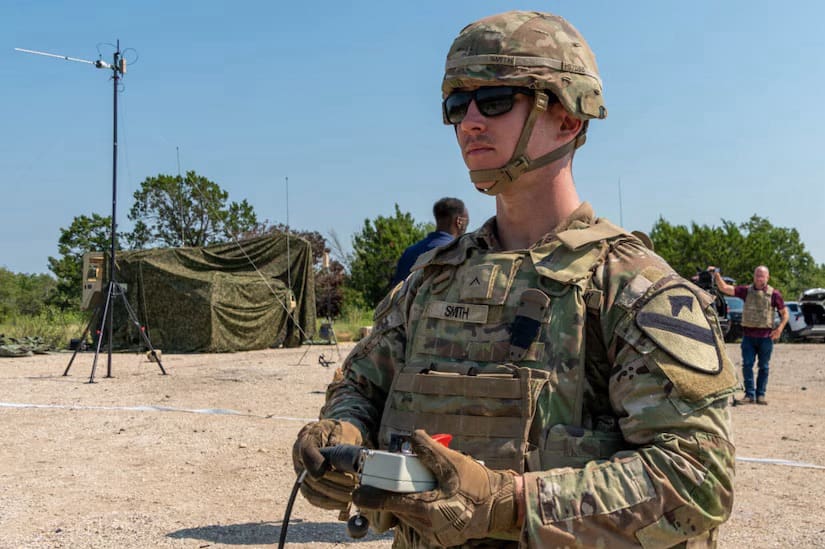
Weller said the Switchblade is just one example of how Transforming in Contact is reshaping the 1st Cavalry Division’s armored formations. He noted that the unit will use the system during their upcoming rotation at the National Training Center at Fort Irwin, California.
“The battlefield is constantly changing, and the Army has to modernize to keep pace,” he said. “Seeing systems like the Switchblade in action shows us the future of how our formations will fight. It’s a big step toward keeping our soldiers safer and more lethal.”
By Heather Ashley, Fort Hood Public Affairs Office
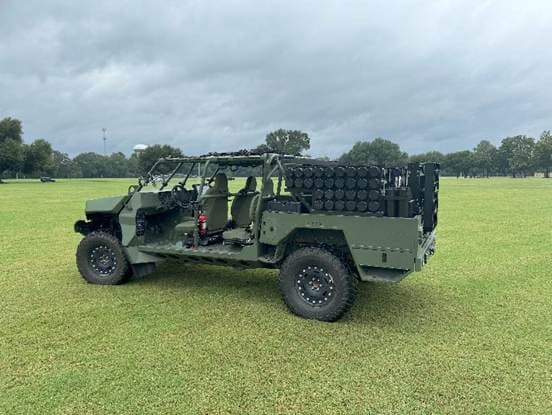
TAMPA, FL – (30, September 2025) – Global Military Products has been invited to participate in the U.S. Army’s Transformation in Contact (TiC) 2.0 with its Scorpion Light 81mm mobile mortar system – under a Soldier Enhancement Program (SEP) contract with the Product Manager for Artillery Mortars and Precision Systems (PdM AMPS). Equipped with government-furnished M253 barrels, soldiers will have the opportunity to experience the latest advancements in mobile mortar technology and contribute to the modernization efforts within the mortar community.
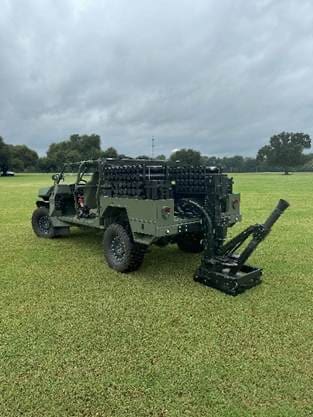
TiC 2.0 launches October 20th in Hawaii, where soldiers will first undergo five days of new equipment training from Global Military Products to achieve the operational knowledge and limited safety release required to live-fire the system. Soldiers will then participate in an additional 10 days of tactical scenarios and simulated combat operations with the Scorpion Light Systems. Training and experimentation will also include the Scorpion Light’s rapid-fire control system – designed to elevate operational efficiency with its ability to auto-lay and auto re-aim.
“Soldier touchpoints like the TiC 2.0 serve as an invaluable platform for government and industry to collaboratively review, assess and innovate with the latest technologies. Most importantly, they facilitate the utilization of soldier feedback to inform requirements and expedite the acquisition process for mortar modernization,” said James Knight, senior Manager, Defense Systems and Energetics, Global Military Products. “As a retired Army mortarman, I am intimately familiar with the Army’s requirements for mortar modernization and strongly support the TiC initiative to swiftly enhance the mobility, lethality, operator safety and air transportability of these assets.”
The Scorpion Light 81mm mobile mortar system can fire eight rounds and relocate in under two minutes, taking just 30 seconds to fire the first round and 30 seconds to displace after firing the last round. The unique, non-seating baseplate allows the system to emplace and displace rapidly and fire on nearly any surface. Its robust design, rugged construction, and resilient technologies make it a durable weapon that can withstand the rigors of combat, extreme temperatures, and harsh conditions, while remaining effective. The Scorpion Light on the IUV, has also been certified in the U.S. to be air-droppable and maintains internal air transportability within a CH-47, supporting expeditionary forces.
The Scorpion Light 81mm mobile mortar system and 72 mortar rounds will be fully integrated on two GM Defense Infantry Utility Vehicles (IUVs), a variant of the U.S. Army Infantry Squad Vehicle (ISV). The modularity of the system, however, is platform agnostic and allows for integration onto any vehicle platform. Integrations have already been completed on a G-Wagon and Polaris MRZR Alpha 4×4 and 6×6 platforms.
Global Ordnance is exhibiting at the 2025 AUSA Annual Meeting in Washington, D.C. October 13-15 in booth #943. The display will include a Scorpion 120mm mobile mortar system integrated on a high mobility multipurpose wheeled vehicle (HMMWV).
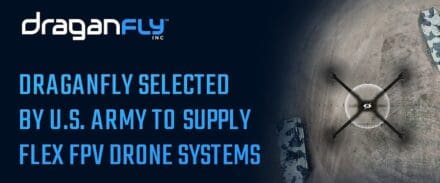
Tampa, Florida – September 30, 2025 — Draganfly Inc. (NASDAQ: DPRO) (CSE: DPRO) (FSE: 3U8) (“Draganfly” or the “Company”), an industry-leading developer of drone solutions and systems, today announced its selection by the U.S. Army to provide Flex FPV drone systems.
Under the initial order, Draganfly will deliver Flex FPV drones designed for high-performance operations as well as help establish on-site manufacturing of the Flex FPV (First Person View) within overseas U.S. Forces facilities to accelerate deployment and reduce supply-chain timelines. The Company will also provide both flight and manufacturing training to enable Army personnel to sustain operations, and will manage logistics to ensure a secure, NDAA-compliant supply chain practice. This marks a significant milestone in evolving critical drone capabilities closer to the theater of operations, reducing logistical vulnerabilities and enhancing force readiness.
Recent exercises have underscored the importance of FPV technology for U.S. forces. During the Swift Response 2025 exercise in Lithuania, paratroopers operated and detonated in-house-built FPV drones against dismounted and vehicle-sized autonomous targets. The unit has also established its own drone lab for design, training, and rapid innovation. In August 2025, the U.S. Army executed the first-ever air-to-air kill with an armed FPV drone, advancing the evolution of drone warfare. Draganfly’s Embedded Manufacturing Program and the Flex FPV Drone systems are in direct support of this strategic shift to decentralized and agile innovation.
“We are honored to support the U.S. Army as it moves critical drone capabilities closer to front lines,”
Cameron Chell, President & CEO
“We are honored to support the U.S. Army as it moves critical drone capabilities closer to front lines,” said Cameron Chell, President & CEO of Draganfly. “By combining advanced Flex FPV Drone systems, embedded manufacturing, training and secure logistics, we are helping reinforce operational agility and sustainment for forward-deployed forces. This helps ensure personnel have the tools, training and capabilities required when and where they need them most.”
Video by SPC Kyle Chacon
1st Special Forces Command (Airborne)
FORT BELVOIR, Va. (Sept. 11, 2025) — The Army recently awarded $65.5 million in delivery orders Sept. 11, 2025, to Hardwire LLC and Leading Technology Composites, Inc., for the production of 72,179 Lightweight Small Arms Protective Inserts (LSAPI). The awards mark the official start of production for LSAPI, the newest component of the Soldier Protection System under Project Manager Soldier Survivability.
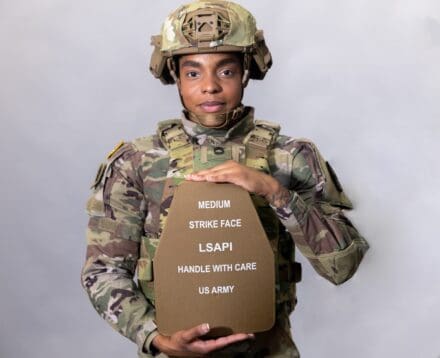
The official contract, awarded under the Army’s existing multiple-award indefinite delivery/indefinite quantity (IDIQ), allows the Army to place orders with approved vendors as requirements are finalized. Delivery Orders W91CRB-25-F-A210 (Hardwire) and W91CRB-25-F-A211 (LTC) were issued under Notice of Fair Opportunity 0001. The total delivery order value of $65,564,335.70 covers 72,179 plates, with anticipated delivery to Program Executive Office (PEO) Soldier within 18 months, no later than March 15, 2027.
LSAPI plates are approximately 30% lighter than the current Enhanced Small Arms Protective Insert (ESAPI) Generation III, reducing the Soldier’s combat load while maintaining ballistic protection. The plates also use a shooter’s cut geometry to improve mobility and range of motion. LSAPI integrates with the Army’s Modular Scalable Vest (MSV) Gen II and other systems in the Soldier Protection System (SPS) family of equipment.
“The Lightweight Small Arms Protective Insert award reflects our team’s dedicated effort to advance and optimize Soldier protection,” said Lt. Col. Ken Elgort, product manager for Soldier Protective Equipment (PdM SPE). “With this milestone, LSAPI moves into production and will soon begin fielding alongside the Modular Scalable Vest, reducing combat load while maintaining state-of-the-art ballistic performance. It also reflects a major win for domestic manufacturing and a proud moment for our team as we deliver on PEO Soldier’s commitment to equip Soldiers with world-class protection,” he added.
The LSAPI award is the latest step in modernization under Product Manager Soldier Protective Equipment (PdM SPE), Project Manager Soldier Survivability (PM SSV), and Program Executive Office (PEO) Soldier, reducing weight, enhancing lethality and delivering modular protection across the Army’s combat formations.
SCHOFIELD BARRACKS, Hawaii – From September 9–18, 2025, the 25th Infantry Division transformed its training areas into a living laboratory for the U.S. Army’s modernization efforts, hosting the xTechPacific 2025 competition.
The event, which brought ten innovative small businesses to Oahu, gave Army and joint leaders a rare chance to see emerging capabilities tested in realistic operational settings. Soldiers of the 25th Infantry Division and partner units integrated new technologies into live experimentation across Schofield Barracks and Joint Base Pearl Harbor-Hickam, culminating in Distinguished Visitors Day on September 18.
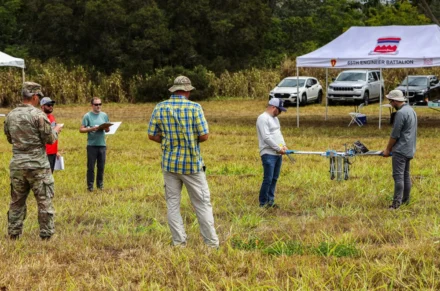
For the 25th Infantry Division, xTechPacific was more than just a showcase of new tools. It was a powerful demonstration of the Army’s Transformation in Contact initiative, which ensures emerging technologies are tested, refined, and employed by operational forces at the point of need.
Transforming in Contact
The Army’s Transformation in Contact initiative is designed to shorten the gap between laboratory innovation and battlefield application. Instead of waiting for long acquisition cycles to deliver fully mature systems, the initiative prioritizes getting promising prototypes into the hands of Soldiers early — allowing them to shape how technology evolves.
As one of the Army’s forward-deployed divisions in the Indo-Pacific, the 25th Infantry Division is uniquely suited for this mission. Its training environments mirror the diverse challenges of the theater: dense jungle terrain, mountainous regions, urban spaces, and maritime surroundings. By hosting xTechPacific 2025, the Division positioned itself as the Army’s bridge between innovators and operational demands.
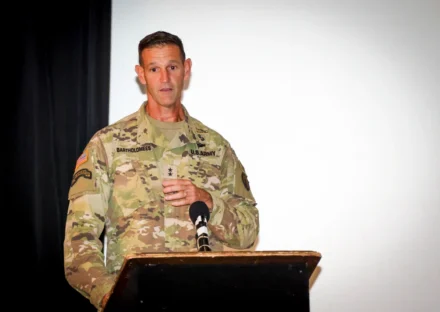
“The 25th Infantry Division is leading the Army in continuous transformation, and we welcome every opportunity to partner with industry,” said U.S. Army Maj. Gen. James Bartholomees, commanding general of the 25th Infantry Division and U.S. Army Hawaii. “This division was the first in contact on the day of Pearl Harbor, and we have remained in contact ever since—that’s why innovation is so critical. Innovation today directly impacts our readiness against both current and future threats in the most dynamic theater in the world.”
Confronting the Hidden Threat: UXO and IED Detection
Few threats create more danger for ground forces than buried explosives and unexploded ordnance (UXO). In the Indo-Pacific, where soils vary from volcanic rock to dense clay, detecting these hazards is particularly challenging.
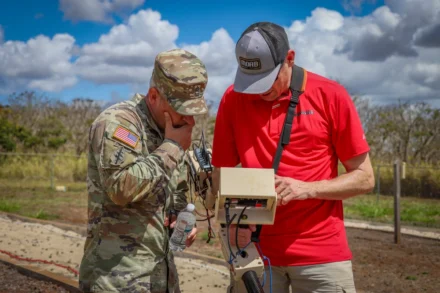
At Schofield Barracks’ South Range, innovators worked side-by-side with Soldiers to test advanced detection technologies. Some systems used drone-mounted magnetometers to map anomalies hidden underground. Others combined ground-penetrating radar with thermal imaging to distinguish between clutter and dangerous ordnance.
Soldiers provided critical feedback on ease of use, portability, and performance under stress. For the Division, these tests were not abstract — they reflected real threats encountered during operations.
“The work being done here in the Indo-Pacific is decisive for giving our troops an advantage in protection and capability,” said U.S. Army Lt. Gen Joel B. Vowell, deputy commanding general of U.S. Army Pacific Command. “When Soldiers, industry, and academia come together in real-world experimentation, the results can be transformational.”
The UXO experimentation underscored Transformation in Contact’s central idea: Soldiers must shape the development of tools that will one day protect them on patrol or in combat. By hosting these trials, the 25th Infantry Division directly influenced how the Army will confront the IED and UXO challenge in the years ahead.
Dominating the Spectrum: Electronic Warfare
Electronic warfare (EW) is one of the most contested domains in modern conflict, and the Indo-Pacific presents unique challenges across vast distances and crowded airwaves. For the 25th Infantry Division, ensuring its formations can fight through interference, jamming, and deception is essential.
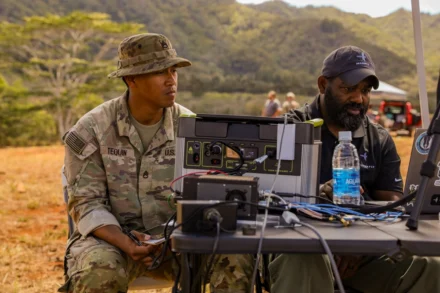
At South Range, Soldiers tested portable spectrum-awareness systems designed to detect and classify enemy signals. These devices, many of them compact enough to fit in a rucksack, used artificial intelligence and advanced processing to rapidly identify emitters across multiple frequencies.
During live scenarios, Soldiers moved through training lanes where they were challenged to detect and respond to simulated electromagnetic threats. Some systems automatically geolocated emitters, allowing units to pinpoint hostile sources. Others provided simplified user interfaces to reduce the cognitive load on Soldiers in fast-moving situations.
“For the first time, Soldier experimentation was incorporated directly into this competition, shaping how technology meets mission needs,” said Jessica Stillman, the U.S. Army xTech program manager. “These innovators received direct feedback from Soldiers and scientists to refine their solutions and ensure operational relevance. This competition embodies how the Army is transforming—incorporating Soldier experimentation into innovation from concept to capability.”
For the Army, xTechPacific’s EW demonstrations showed how Soldier feedback can make advanced technologies more practical for the field. For the 25th Infantry Division, the event reinforced its role as a leader in shaping the Army’s ability to dominate the spectrum in contested environments.
Securing the Seas: Watercraft Defense and Logistics
Operating in the Indo-Pacific means operating across the world’s largest maritime theater. For the Army, this requires not only defending watercraft from threats but also sustaining forces across distributed islands and austere shorelines.
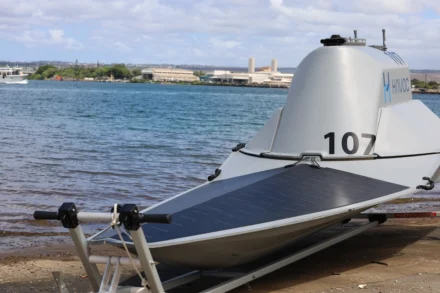
At Ford Island Waterway and later at Schofield Barracks, the 25th Infantry Division helped evaluate technologies designed to meet these challenges head-on.
Autonomous surface vessels demonstrated their ability to provide layered defense for logistics convoys, escorting larger craft while detecting and neutralizing potential threats. Other systems focused on logistics, showcasing modular platforms that could be assembled in shallow waters to support distributed operations.
Soldiers tested these systems in scenarios simulating contested maritime environments, providing input on maneuverability, reliability, and adaptability to real-world missions.
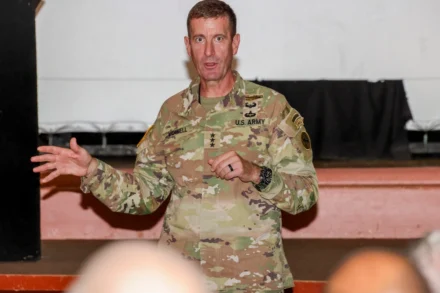
“I’ve seen firsthand how Soldiers, warrant officers, and industry working together can develop life-saving solutions in combat,” said Vowell. “We don’t have the luxury of mass; instead, we must innovate asymmetrically to offset our adversaries’ advantages.”
The Division’s role in hosting these demonstrations highlighted how Transformation in Contact extends beyond the battlefield ashore. By testing technologies in Hawaii’s waterways, the 25th Infantry Division reinforced its readiness to operate in a truly joint, multi-domain environment.
Distinguished Visitors Day: Showcasing Innovation
On September 18, senior Army and joint leaders gathered at Schofield Barracks for Distinguished Visitors Day, the capstone event of xTechPacific 2025.
Guests observed live technology demonstrations in the morning before transitioning to Schofield’s Sgt. Smith Theater for a watercraft expo and the award ceremony. There, the Army recognized three winning innovators, each earning prize funding and the opportunity to pursue further development under the Army’s Small Business Innovation Research program.
“The ideas and technologies you bring will help our reconnaissance companies deploy, fight, and win in multi-domain operations” said Bartholomees.
For leaders, the day was about more than recognizing innovation — it was about seeing firsthand how the Army is accelerating modernization by placing Soldiers at the center of experimentation.
A Division at the Forefront
The xTechPacific 2025 competition reaffirmed the 25th Infantry Division’s position as one of the Army’s leading formations in modernization. By hosting live experimentation in Hawaii, the Division not only validated promising technologies but also demonstrated how the Army is operationalizing its Transformation in Contact initiative.
“Innovation today directly impacts our readiness against both current and future threats in the most dynamic theater in the world,” said Bartholomees.
As the Army looks to the future, the 25th Infantry Division’s role will remain vital. Positioned at the center of the Indo-Pacific, the Division will continue to connect innovators with operational realities, ensuring Soldiers remain ready, lethal, and adaptive in the face of evolving threats.
The Division’s leadership in this effort is not new. Over the past several years, the 25th Infantry Division has been at the cutting edge of transformation by fielding and refining some of the Army’s newest capabilities. The High Mobility Artillery Rocket System (HIMARS) has already proven its value in Pacific-focused training exercises, providing long-range precision fires that extend the Division’s reach across the region’s vast maritime and island geography. By incorporating HIMARS into distributed operations, the Division has shown how precision fires can deter aggression and provide critical options to commanders.
The Division has also embraced the Infantry Squad Vehicle (ISV), a lightweight, highly mobile platform that increases the agility of small units in jungle and mountainous terrain. Soldiers have employed ISVs in rigorous training scenarios across Hawaii, demonstrating how these vehicles enhance maneuverability, reduce fatigue, and enable faster movement in terrain that would otherwise slow infantry forces.
Beyond new equipment, the Division has restructured its formations to better align with the demands of multi-domain operations. Adjustments in task organization, command relationships, and sustainment practices reflect lessons learned through repeated experimentation. These changes allow the Division to operate more effectively as part of joint and coalition task forces, ensuring its units are ready to fight and sustain operations across dispersed island chains.
By combining these advancements with its role as host of xTechPacific, the 25th Infantry Division continues to demonstrate how Transformation in Contact is more than a concept — it is a daily practice. Positioned at the center of the Indo-Pacific, the Division will remain the Army’s proving ground for innovation, ensuring Soldiers stay ready, lethal, and adaptive in the face of evolving threats.
“The technologies showcased [at xTechPacific] will not only serve the Army, but also benefit society,” said Bartholomees. “Their dual-use applications, ranging from disaster response to infrastructure security, demonstrate how military innovation drives national progress and resilience.”
Story by SSG Alvin Conley
25th Infantry Division